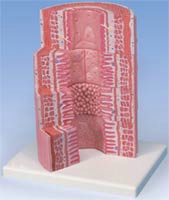Home » Hospital & Durable Medical Equipment » Using a Colon Model to Understand the Colon » Using a Colon Model to Understand the Colon
Using a Colon Model to Understand the Colon

Diseases of the Esophagus Anatomical Model
Retail Price: $135.18
Your Price: $97.53
 Unit: single
Unit: single

Standard Anatomical Hemorrhoid Model
Retail Price: $135.18
Your Price: $97.53
 Unit: single
Unit: single

Magnified Digestive System Anatomy Model
Retail Price: $564.07
Your Price: $444.60
 Unit: single
Unit: single
Basic human anatomy class, or even a more advanced course can often be very mundane and redictable in presentation. There is the lecture, the accompanying overhead presentation, and occasionally some online work to complete the section.One unique way to add a bit of variety to an anatomy class would be to include anatomical models in the coursework. This can be done right in the class during the lecture, or it can also be seen as a laboratory project that follows up on the class lecture. The more challenging the anatomical part is to study the better a model is suited to the task.
The digestive system is one area where the learning experience would be greatly improved through the use of anatomy models. A colon model can be used in conjunction with an overall digestive system model to allow students to learn about the important functions of the lower part of the gastrointestinal tract. A very unique type of colon model will combine the normal features of a healthy colon with the conditions most associated with common diseases of the colon. This combination will keep students interested while also providing a visual image that will help in developing a solid understanding of this part of the body.
A colon model doesn't have to be huge and confusing, all bundled tightly together. Instead it can be highly accurate in shape and design but very simple and straightforward in presentation. Having parts of the colon displayed as cut-aways allows the inner sections that are most commonly associated with disease conditions to be highly visible. Common diseases addressed in a colon model include Crohn's disease, polyps, spastic colon, ulcerative colitis, adhesions, bacterial infections, cancers and even appendicitis and diverticulitis. A card located behind the colon model makes identification of the disease conditions very simple. Allowing the students to use the card to study is a great way to build knowledge and provide quick references. The same model, with the card removed, can also be used as a self-test or a part of a lab test in later classes.
Other options for a colon model can include a cross sectional type of model. This model allows the students to look at the colon cut into cross-section rings. These rings are hinged to a central back and swing out to allow a view into the colon itself. This colon model is divided into four sections that include a normal section, cancer, chronic colitis and diverticulitis. Students will be able to indentify the parts of the colon in each of the sections. This model is very small and ideal for comparison types of projects. It is also a great model to use when working with students in small groups or at laboratory tables. The colon model options really do vary based on the specific features that are taught in the lesson. For a full anatomy class the colon model should be used in conjunction with a model of the rectum as well as the full GI tract for a very comprehensive understanding.
MSEC remains dedicated to providing the very best and the very latest in medical supplies and equipment. We never cease to be on the lookout for the latest innovation that will benefit both our many clients and the patients they dedicate their lives to caring for. If you have any difficulty finding your choices in our vast inventory, call our customer service at 1-877-706-4480 to speed up your order or to make a special request. We are always happy to help you.














